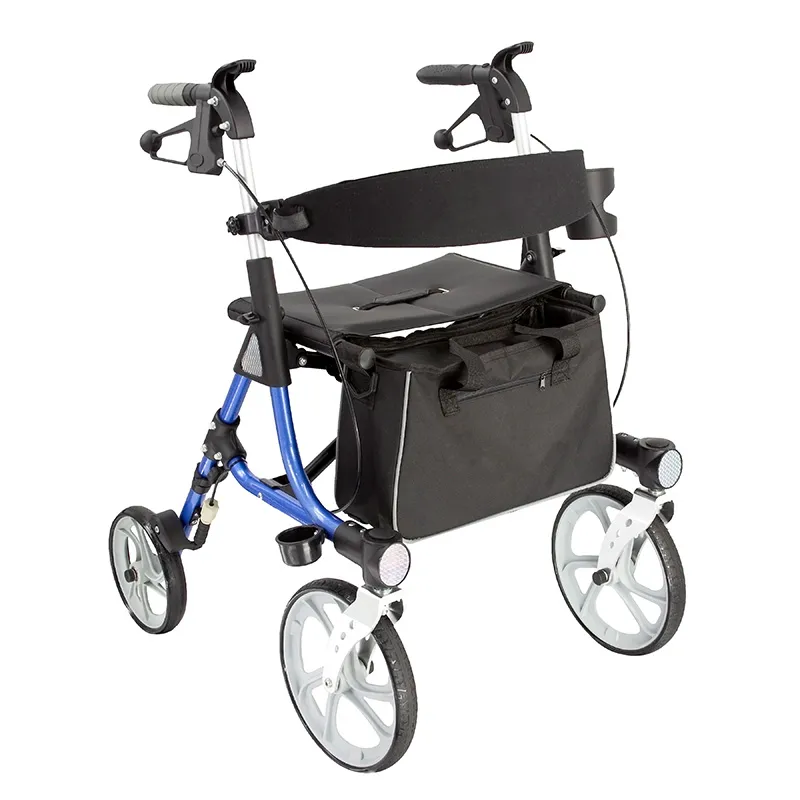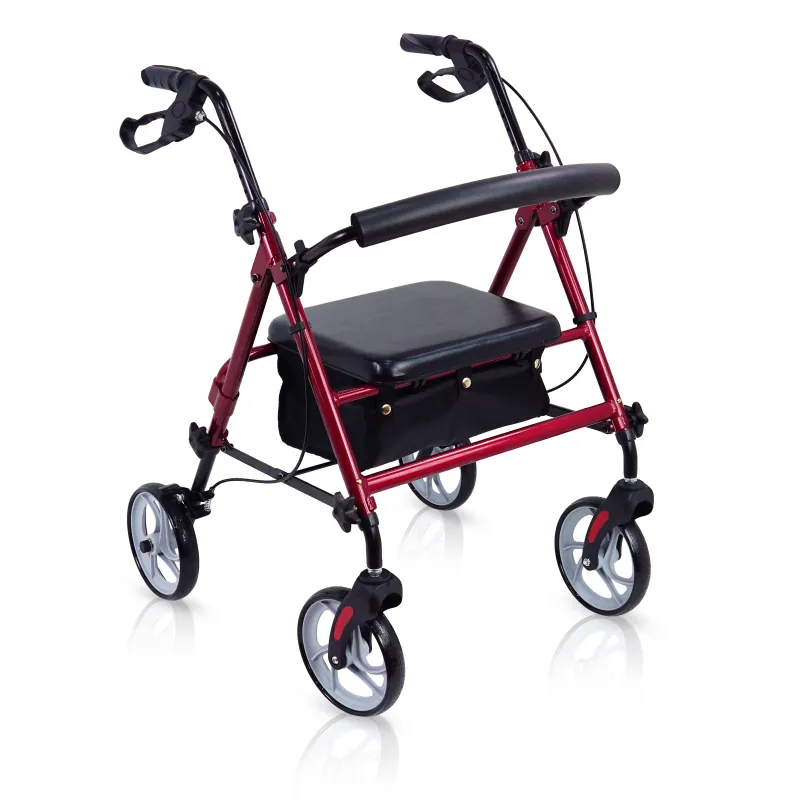
What is a light weight rollator? What does it do?
2024-10-16 15:30
A light weight rollator is a mobility aid designed for people with limited mobility. Compared with traditional walkers, light weight rollators have the advantages of light weight, strong portability, and easy operation. This article will introduce the definition, structural characteristics, usage methods, and role of light weight rollators in improving the quality of life of users in detail.

What is a light weight rollator?
A light weight rollator is a mobility aid with four wheels, hand brakes, and a seat. It provides additional support for people with limited mobility, helping them to walk more safely and stably in their daily lives. The design of the light weight rollator focuses on lightness and easy operation, making it suitable for the elderly, rehabilitation patients, and other people who need assisted walking.
What are the structural features of a light weight rollator?
The main structure of a light weight rollator includes a frame, wheels, hand brakes, seats, and storage baskets. The following is a detailed introduction to these components:
1. Frame: The frame of a light weight rollator is usually made of aluminum alloy or other lightweight materials, which is both light and strong. The design of the frame takes ergonomics into consideration to ensure the comfort and stability of the user when walking.
2. Wheels: A light weight rollator is equipped with four wheels. The front wheel usually swivels for easy steering, while the rear wheel provides stability. The size of the wheels is generally between 6 and 8 inches, suitable for various ground conditions.
3. Handbrake: The handbrake is an important safety device for light weight rollator. The user can control the movement of the vehicle through the brake system on the handle to prevent sliding or accidents.
4. Seat: A light weight rollator is equipped with a comfortable seat, where users can sit and rest at any time when they are tired of walking. The seat is usually designed with a backrest to provide better support and comfort.
5. Storage basket: Most light weight rollators are equipped with a storage basket or bag for users to carry personal belongings such as shopping bags, books or medicines.
How should I use a light weight rollator?
When using a light weight rollator, you need to pay attention to the correct operation method to ensure safety and comfort. Here are the basic steps and precautions for using a light weight rollator:
Adjust the height:
First, adjust the height of the rollator according to the user's height. Make sure the height of the handle is suitable for the user to hold it naturally when standing, with the arm slightly bent. Handles that are too high or too low can affect the user's comfort and safety.
Walking posture:
When walking with a light weight rollator, you should keep your body upright, hold the handles with both hands, and gently push the vehicle forward. The front wheel can rotate for easy steering, and the rear wheel provides stability to ensure a smooth walk.
Using the handbrake:
When you need to stop, the user can hold the brake system on the handle to fix the rollator in place. Especially on slopes or uneven surfaces, the handbrake can prevent the rollator from accidentally sliding and provide additional safety.
Sit down to rest:
If you need to rest, the user can park the rollator, make sure the handbrake is locked, and then sit on the rollator seat. The light weight rollator seat is designed to be comfortable and suitable for short breaks.

What does a light weight rollator do?
The main functions of a light weight rollator: provide stable walking support (reduce the risk of falling), enhance independence (reduce dependence on others), provide a convenient resting place (avoid excessive fatigue), and facilitate carrying personal belongings.
Provide stable walking support:
The light weight rollator provides stable support for users, helping them maintain balance while walking. Especially for the elderly, rehabilitation patients and people with limited mobility, the light weight rollator can reduce the risk of falling and enhance the safety and confidence of walking.
Enhance independence:
With the light weight rollator, people with limited mobility can complete daily activities such as shopping, walking or going out for social activities more independently. The portability and easy operation of the light weight rollator enable users to travel more independently and reduce their dependence on others.
Provide a convenient resting place:
The light weight rollator is equipped with a comfortable seat, and users can sit down and rest at any time when they are tired of walking. This design not only provides convenience, but also helps users avoid excessive fatigue and protect their health when walking for a long time.
Easy to carry personal belongings:
The storage basket or bag of the light weight rollator can be used to carry personal belongings, such as shopping bags, books or medicines, freeing the user's hands and increasing the convenience of travel.

How to choose and maintain a light weight rollator?
Choosing the right light weight rollator and regular maintenance are important links to ensure its safe and comfortable use.
Choosing the right light weight rollator:
When choosing a light weight rollator, there are several factors to consider:
● Weight: The weight of a light weight rollator is an important consideration, usually between 6 and 8 kg. Choose a light but sturdy rollator that is easy to carry and operate.
● Size: The size of the rollator should be suitable for the user's height and body shape to ensure comfort and safety. Adjust the handle height and seat height to suit the user's needs.
● Wheels: The size and material of the wheels affect the stability and portability of the rollator. Choose wheels suitable for various ground conditions to ensure smooth walking.
● Safety: Check the handbrake system and other safety devices of the rollator to ensure that they provide reliable safety protection during use.
Maintenance and care:
Regular maintenance of the light weight rollator can extend its service life and ensure its safety and comfort during use:
● Cleaning: Clean the rollator regularly and keep the frame, seat and storage basket clean. In particular, the wheels and handbrake system need to be kept clean to prevent dust and dirt from affecting their function.
● Inspection: Regularly check the various parts of the rollator, such as screws, wheels, handbrakes, etc., to ensure that they are not loose or damaged. Repair or replace them in time if any problems are found.
● Storage: When not in use, store the rollator in a dry, ventilated place, away from direct sunlight and humid environment to prevent material aging and damage.








